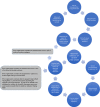Diagnosis and Management of Anabolic Androgenic Steroid Use
- PMID: 30753550
- PMCID: PMC6517163
- DOI: 10.1210/jc.2018-01882
Diagnosis and Management of Anabolic Androgenic Steroid Use
Abstract
Context: The lifetime prevalence of anabolic androgenic steroid (AAS) use is estimated at 1% to 5% worldwide. AAS use occurs primarily male elite athletes and men who want a muscular appearance. The evidence for effective, safe management of AAS cessation and withdrawal is weak.
Design: Key studies were extracted from PubMed (1990-2018) and Google Scholar with reference searches from relevant retrieved articles.
Results: The proven adverse effects of AASs include suppression of the gonadal axis and infertility, hirsutism and defeminization in women, and erythrocytosis. Alkylated AASs that are taken orally may cause hepatopathy. There is an association between high-dosage AAS use and increased risk of cardiovascular disease. Clues for AAS use include very low serum high-density cholesterol and sex hormone-binding globulin concentrations and unexplained erythrocytosis. For elite athletes, the biological passport (monitoring of blood or urinary androgen and androgen precursor concentrations after determining the athlete's baseline) is useful for detecting AAS use. For nonelite athletes, the best method to confirm AAS use is to inquire in a nonjudgmental manner. Cessation of chronic AAS use is associated with a withdrawal syndrome of anxiety and depression.
Conclusions: Men who use AASs <1 year typically recover normal hypothalamic-pituitary-testicular axis function within 1 year after cessation. Men who have infertility due to high-dosage AAS use ≥1 year might benefit from short-term treatment with clomiphene or human chorionic gonadotropin.
Copyright © 2019 Endocrine Society.
Figures


Comment in
-
Re: Diagnosis and Management of Anabolic Androgenic Steroid Use.J Urol. 2020 Feb;203(2):239. doi: 10.1097/01.JU.0000614760.48465.df. Epub 2019 Nov 11. J Urol. 2020. PMID: 31710536 No abstract available.
References
-
- Cussons AJ, Bhagat CI, Fletcher SJ, Walsh JP. Brown-Séquard revisited: a lesson from history on the placebo effect of androgen treatment. Med J Aust. 2002;177(11-12):678–679. - PubMed
-
- Kanayama G, Pope HG Jr. History and epidemiology of anabolic androgens in athletes and non-athletes. Mol Cell Endocrinol. 2018;464:4–13. - PubMed
-
- Bhasin S, Storer TW, Berman N, Callegari C, Clevenger B, Phillips J, Bunnell TJ, Tricker R, Shirazi A, Casaburi R. The effects of supraphysiologic doses of testosterone on muscle size and strength in normal men. N Engl J Med. 1996;335(1):1–7. - PubMed
-
- de Hon O, Kuipers H, van Bottenburg M. Prevalence of doping use in elite sports: a review of numbers and methods. Sports Med. 2015;45(1):57–69. - PubMed

